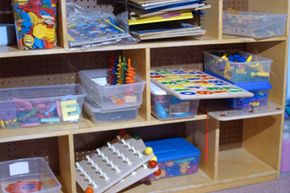Home Improvement

Maintaining a clean and tidy child’s room can be made easier with a well-planned organizational system. See more pictures of toys.
Thinkstock Images/Comstock Images/Getty Images
The key to a clean house is organization. Having a designated place for everything makes it easier to clean up and restore a room to its former state. However, some areas of the house seem to be in a constant state of disarray, particularly children’s bedrooms and playrooms. With an abundance of toys, art supplies, games, and building blocks, it can be a challenge to keep everything organized. The first step in reducing clutter is developing an effective plan for organizing your children’s toys.
Chances are, your children have amassed a large collection of toys. Some of these toys may no longer be age-appropriate or relevant to their interests, while others are cherished and played with on a regular basis. If you are revamping your child’s playroom, you will need to sort through their toys and determine which items can be discarded, and which require storage containers that are practical, durable, and easy for your children to use [source: Today].
Once you have established an organizational system, it is important to maintain it. You can break down the process into various steps, such as daily tidying, weekly deep cleaning, and annual purging of old toys. By keeping up with organization, and encouraging your children to do the same, you can effectively manage the clutter in your playroom, and focus on what truly matters: spending time with your children.
The first step in organizing a playroom is taking inventory of your child’s toys. Keep reading for tips on how to get started.
Taking Inventory of Your Child’s Toys
Between holidays, birthdays, and other special occasions, children receive an abundance of new toys each year, making it overwhelming to determine how and where to store them. Therefore, the first step in organizing your child’s playroom is to evaluate what you already have. This may involve discarding some toys, which will make the organization process much simpler.
To begin, take an inventory of your child’s toys and games. Look for duplicates, broken toys, items with missing pieces, and toys that are no longer played with. While this may appear to be a daunting task, having a clear understanding of what is present in your playroom will make the remaining organizational steps more manageable.
Once you have generated a comprehensive list, sort the toys into three categories: items to keep, broken toys to discard, and gently used toys to donate. Involve your children in this process and allow them to select which toys they want to keep or donate. Establish some guidelines and let your kids make the decision. You may be surprised at how excited they are to donate their old toys to less fortunate children [source: Rosemond].
Once you have an understanding of the toys in your playroom, it’s time to reduce the clutter. Sorting toys into manageable groups can help to organize the playroom and make it easier for children to find what they want. Many parents find that fewer toys can lead to more playtime and imaginative play. Sorting toys by genre or frequency of use can help create “play zones” in the playroom. Labels can also be useful in keeping things organized. It’s important to periodically purge the playroom of toys that are broken or no longer used.
To encourage your children to donate their unused toys, talk to them about how they can help another child. Establish guidelines for how many items they can keep, and let them do most of the sorting. If you’re hesitant to dispose of toys, keep durable and classic items, like building blocks or doll clothes, for your younger children. Store family heirlooms in a dry, controlled space. To organize your playroom, take cues from your child’s classroom. Use extra shelving, placing frequently used toys at eye level. Label storage bins for smaller toys and limit the number of large bins. You can repurpose old shoe boxes or baskets to save money.
Additional Information
Related Articles from HowStuffWorks
- Ways to Arrange a Kid’s Room
- How to Organize a Basement
- How to Manage Holiday Decorations
References
- Castagnoli, Francesca. “Strategies for Decluttering Your Child’s Playroom.” Parents. April 2009. (Accessed 1/15/10) http://www.parents.com/parenting/moms/declutter-your-play-room/
- Ewer, Cynthia. “8 Excellent Tips for Organizing Kids’ Rooms.” Organized Home. 2009. (Accessed 1/15/10) http://organizedhome.com/get-organized/tips-organize-kids-rooms
- Gaulin, Pam. “Tips on Organizing a Child’s Bedroom.” Modern Mom. October 11, 2009. (Accessed 1/15/10) http://www.modernmom.com/article-3585-organization-tips-for-a-childs-bedroom/
- Good Housekeeping. “52 Techniques for Organization.” 2010. (Accessed 1/15/10) http://www.goodhousekeeping.com/home/organizing/how-to-get-organized
- Good Housekeeping. “Cleaning and Organizing Kids’ Toys.” 2010. (Accessed 1/15/10) http://www.goodhousekeeping.com/home/organizing/organize-toys?click=main_sr
- Parents. “Intelligent and Simple Space Savers”. 2010. (Accessed 1/15/10) http://www.parents.com/parenting/moms/space-savers/?page=2
- Parenting. “Play Zone.” 2010. (Accessed 1/15/10) http://www.parenting.com/gallery/-/Play-Zone-1000018998/13/
- Rice, Bonnie. “Tips for Organizing Your Toys.” iVillage. 2009. (Accessed 1/15/10) http://parenting.ivillage.com/mom/organization/0,,433f,00.html
- Rosemond John. “Do You Have Too Many Toys?” Better Homes and Gardens. 2010. (Accessed 1/15/10) http://www.bhg.com/health-family/parenting-skills/family-relationships/too-many-toys/
- Today. “How to Arrange Your Child’s Playroom.” MSNBC. (Accessed 1/19/10) http://today.msnbc.msn.com/id/15734742/
FAQ
1. What are some tips for organizing kids’ toys?
Start by sorting through the toys and getting rid of anything that is broken, missing pieces, or no longer played with. Then, divide the remaining toys into categories such as building blocks, dolls, or cars. Use labeled bins or baskets to store each category and make sure they are easily accessible for kids to find and put away.
2. How can I involve my child in organizing their toys?
Make organizing a fun activity by involving your child in the process. Ask them to help categorize the toys and choose where they should be stored. Encourage them to decorate the storage bins or baskets to make them more personal and appealing. Celebrate the accomplishment of a well-organized toy area with a special treat or outing.
3. How often should I declutter and reorganize my child’s toys?
It’s good to declutter and reorganize toys on a regular basis, such as every few months. This will prevent the accumulation of too many toys and help keep the toy area organized. Encourage your child to participate in the process and donate any toys that are no longer needed to a local charity.
4. What’s the best way to store stuffed animals?
Stuffed animals can take up a lot of space, so it’s best to store them in a hammock or hanging net that can be hung on the wall or ceiling. Another option is to use a large clear bin with a lid, which can be easily stored in a closet or under the bed. Make sure to wash the stuffed animals before storing them to keep them clean.
5. How can I keep small toys organized?
Small toys like action figures or Barbie accessories can easily get lost or mixed up. Use small plastic containers or ziplock bags to store them, and label them with the toy’s name or category. These containers can be stored in a larger bin or basket with other toys of the same category.
6. What are some creative storage ideas for art supplies?
For art supplies like markers, crayons, and paint, use a caddy or lazy susan to keep them organized and easily accessible. Another option is to use a hanging shoe organizer with clear pockets to store art supplies. This allows for easy visibility and saves space.
7. How can I make toy storage part of the decor?
Toy storage can be both functional and stylish. Choose storage bins or baskets that match the room’s decor and add a personal touch. For example, use personalized bins with your child’s name or favorite character. Consider using a bookshelf with labeled baskets or bins to display and store toys, books, and other items.

Brody is a skilled craftsman and gardening expert. From renovating living spaces to cultivating lush gardens, Brody’s knowledge and passion shine through, inspiring readers to embark on their own home improvement and gardening journeys with confidence.






Leave a Reply